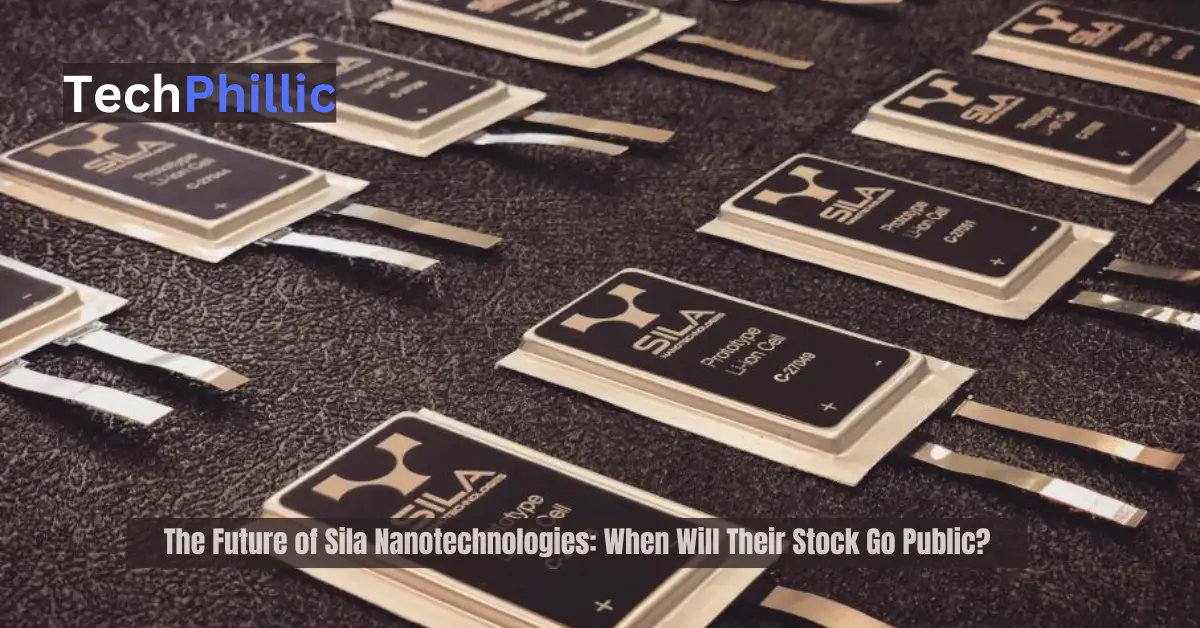Sila Nanotechnologies is an American battery manufacturer that produces lithium–silicon batteries using nanoengineered silicon particles. The company creates battery materials to replace traditional graphite anodes with a silicon-dominant composite material, in order to increase energy density. The company is building a factory in Moses Lake in Washington state.
Sila was founded in 2011 by Gleb Yushin, Alex Jacobs, and Gene Berdichevsky. The company’s name, Sila, is derived from the Ukrainian and Russian word for “power”.
Sila’s technology has the potential to revolutionize the battery industry. By replacing graphite with silicon, Sila’s batteries can store up to 10 times more energy, which could lead to longer-lasting, more powerful electric vehicles.
Sila’s technology is still in the early stages of development, but the company has already made significant progress. In 2023, Sila announced the availability of Titan Silicon, its first anode product. Titan Silicon is currently being used in consumer electronics products, and Sila plans to bring it to the automotive market in the near future.
Sila is a privately held company, but it has raised significant funding from investors such as Coatue Management, BMW, and Daimler. The company’s valuation is currently estimated to be around $3.3 billion.
Sila is one of a number of companies working to develop new battery technologies that could revolutionize the electric vehicle market. Other companies in this space include QuantumScape, Solid Power, and Amprius.
Here are some of the key benefits of Sila Nano-technologies’ technology:
- Increased energy density: Sila’s batteries can store up to 10 times more energy than traditional lithium-ion batteries. This means that electric vehicles could have a longer range and be recharged more quickly.
- Improved performance: Sila’s batteries are also more resistant to degradation, which means that they can last longer.
- Reduced cost: Sila’s technology is expected to be more cost-effective than traditional lithium-ion batteries. This could make electric vehicles more affordable.
Sila Nano-technologies is a promising company with the potential to revolutionize the battery industry. If the company is successful, its technology could have a major impact on the electric vehicle market.
In the ever-evolving landscape of nanotechnology, Sila Nano-technologies has emerged as a prominent player, captivating the attention of investors and technology enthusiasts. With their groundbreaking advancements in battery technology, Sila Nanotechnologies has the potential to revolutionize the way we use and store energy.
As interest in Sila Nano-technologies stock going public continues to grow, investors and industry observers eagerly await news of its initial public offering (IPO). This article explores the factors that may influence Sila Nanotechnologies’ decision to go public and sheds light on the timeline and possibilities ahead.
Disclaimer: The information provided in this article is for informational purposes only and does not constitute financial advice. Investors should conduct their own research and consult with a professional financial advisor before making any investment decisions.

Brief Overview:
Sila Nanotechnologies: Empowering a Sustainable Future
Sila Nano-technologies, established in 2011, has dedicated nearly a decade to developing batteries with higher power density and lower costs. Their innovative approach and unwavering commitment to battery technologies have propelled them to the forefront of the industry.
By utilizing nanocomposites and leveraging silicon as an anode material, Sila Nano-technologies aims to enhance the energy storage capabilities of lithium-ion batteries. This technological breakthrough has significant implications for various sectors, including electric vehicles, consumer electronics, and wearable technologies.
The Heightened Interest: Sila Nanotechnologies’ Journey to Public Listing
As Sila Nano-technologies continues to make remarkable strides, the question on everyone’s mind is: When will Sila Nano-technologies stock go public? The anticipation surrounding Sila Nano-technologies’ IPO is driven by the company’s extraordinary potential and the market’s growing interest in sustainable energy solutions. Investors and technology enthusiasts recognize the transformative impact Sila Nano-technologies’ battery technology can have on multiple industries.
Factors Influencing the Decision to Go Public
Several critical factors influence Sila Nano-technologies’ decision regarding its IPO. Understanding these factors provides insights into the timeline and potential outcomes:
1. Technological Advancements and Market Readiness
2. Financial Performance and Growth Trajectory
3. Competitive Landscape and Intellectual Property Portfolio
4. Leadership and Investor Confidence
5. Regulatory and Legal Considerations
Detailed Overview
Unveiling the Potential of Sila Nanotechnologies: A Comprehensive Overview
Background and History of Sila Nanotechnologies
Sila Nano-technologies was founded in 2011 by Gene Berdichevsky, a former Tesla engineer. The company is headquartered in Santa Clara, California, and has offices in Detroit, Michigan, and Seoul, South Korea.
Sila Nano-technologies’ core focus is the development of next-generation battery materials. The company’s proprietary silicon anode technology has the potential to significantly increase the energy density and performance of lithium-ion batteries. This could lead to longer-range electric vehicles, more powerful laptops, and other sustainable energy solutions.
Pioneering Battery Technology Advancements
At the core of Sila Nano-technologies’ groundbreaking work lies their innovative approach to battery technology. They have been focused on replacing traditional graphite anodes with silicon—an element that offers significantly higher energy storage capabilities.
By utilizing silicon-based anodes, Sila Nano-technologies’ lithium-ion batteries can achieve a remarkable 20% increase in power immediately. This breakthrough technology holds immense potential for revolutionizing energy storage and transforming various industries.
Transforming the Landscape of Sustainable Energy Solutions
Sila Nano-technologies’ unique battery technology has the potential to reshape the way we use and store energy. With their lithium-ion batteries powered by silicon, they enable devices to operate for longer periods without the need for frequent recharging.
This has crucial implications for the rapidly evolving electric vehicle industry, where extended battery life and increased range are highly sought after. By collaborating with leading automakers such as BMW and Daimler, Sila Nano-technologies is actively contributing to the mass adoption of electric vehicles.
Recent Developments and Notable Recognition
Sila Nano-technologies’ relentless pursuit of excellence has garnered significant attention and recognition within the industry. The company has attracted substantial investments, including a recent funding round where they secured $590 million.
This infusion of capital has bolstered their growth plans, allowing them to expand their operations and accelerate the development of their battery technology. Moreover, Sila Nano-technologies’ collaborations with renowned companies like Apple and Google in the field of wearable technology further demonstrate their industry prominence and potential for future success.
The Path to Going Public
As Sila Nano-technologies continues to achieve significant milestones and gain recognition for its technological advancements, the question arises: when will Sila Nano-technologies stock go public?
While no official announcement has been made, the company’s remarkable progress, strategic partnerships, and the increasing demand for sustainable energy solutions provide a compelling case for a potential initial public offering (IPO).
Investors and technology enthusiasts eagerly anticipate the news of Sila Nano-technologies’ public listing, recognizing the transformative impact the company can have on multiple industries.
Stay tuned for updates on Sila Nano-technologies’ journey, as they redefine the future of battery technology and pave the way for a sustainable and energy-efficient world.
The Pros and Cons of Going Public: Evaluating the Path for Sila Nanotechnologies
Pros of Going Public
- Increased Capital and Liquidity
By going public, Sila Nanotechnologies can access the public markets and raise substantial capital through the sale of shares.
This influx of funds can be used to fuel the company’s growth, invest in research and development, expand manufacturing capabilities, and explore new market opportunities.
Moreover, going public provides liquidity to existing shareholders, allowing them to monetize their investments and potentially attract new investors.
- Access to Public Markets and Top Talent
Going public can significantly enhance Sila Nanotechnologies’ visibility and reputation. The company’s listing on a stock exchange can attract top talent and help in recruiting skilled professionals who are drawn to the opportunity to work for a publicly-traded company.
The public status also enables Sila Nano-technologies to form strategic partnerships more easily and establish collaborations with industry leaders, fostering innovation and driving future growth.
- Enhanced Brand Recognition and Credibility
Being a public company increases brand recognition and credibility among customers, suppliers, and partners. The public status signals that Sila Nano-technologies has met stringent regulatory requirements and financial standards, instilling confidence in stakeholders.
This enhanced reputation can lead to expanded market reach, improved customer trust, and a competitive edge in the industry.
Cons of Going Public
- Regulatory Compliance and Reporting Requirements
Going public brings an array of regulatory and compliance obligations. Sila Nanotechnologies would need to adhere to the rules and regulations imposed by regulatory bodies such as the Securities and Exchange Commission (SEC).
This involves extensive financial reporting, disclosure requirements, and ensuring compliance with securities laws. The company must also establish robust internal controls and corporate governance practices, which can be resource-intensive and time-consuming.
- Loss of Control and Increased Shareholder Scrutiny
As Sila Nano-technologies goes public, the founders and existing shareholders may experience a dilution of control as outside investors acquire shares. The decision-making process may become more complex, requiring alignment with shareholders’ interests and increased transparency.
Shareholders, including institutional investors, may scrutinize the company’sperformance and demand consistent financial results, potentially limiting flexibility and introducing short-term pressures.
- Market Volatility and Financial Expectations
Publicly-traded companies often face market volatility, with share prices influenced by various factors, including market sentiment and economic conditions. Sila Nano-technologies would need to manage investor expectations and navigate potential short-term fluctuations in stock price.
The company will be expected to deliver consistent financial performance, meet analyst expectations, and provide transparent communication to investors, which can be challenging in a dynamic and competitive market.
Evaluating the Path Forward
Going public presents both advantages and challenges for Sila Nano-technologies. While the potential benefits include increased capital, access to public markets, and enhanced brand recognition, the company must carefully consider the associated risks and responsibilities.
Sila Nano-technologies should assess its readiness to comply with regulatory requirements, navigate market volatility, and maintain a long-term growth strategy. By conducting a comprehensive analysis and seeking professional advice, Sila Nano-technologies can make an informed decision regarding the timing and feasibility of going public.
Factors Influencing Sila Nanotechnologies’ Decision: A Comprehensive Analysis
As Sila Nano-technologies contemplates the decision to go public, several key factors come into play. Understanding these factors is crucial for evaluating the feasibility and potential outcomes of an initial public offering (IPO).
This analysis takes an in-depth look at the factors that could influence Sila Nano-technologies’ decision-making process.
Market Conditions and Industry Trends
Market Conditions
The market conditions for IPOs in 2023 are uncertain. The stock market has been volatile in recent months, and there is some concern that the IPO market could cool down. However, there is still a lot of interest in innovative companies with disruptive technologies. If Sila Nano-technologies goes public in 2023, it will be interesting to see how the market reacts.
Industry Trends
The nanotechnology industry is growing rapidly. The global nanotechnology market is expected to reach $1.5 trillion by 2025. This growth is being driven by the increasing demand for nanotechnology-enabled products and services in a variety of industries, including healthcare, energy, and manufacturing.
Recent Successful IPOs
There have been a few recent successful IPOs in the nanotechnology sector. In 2022, Nanosys went public and raised $100 million. Nanosys is a company that develops and sells nanomaterials for use in a variety of applications, including electronics, energy, and healthcare.
In 2023, Nanoscope went public and raised $50 million. Nanoscope is a company that develops and sells nanoscale imaging systems for use in a variety of applications, including research and development, quality control, and forensics.

Potential Impact on Sila Nanotechnologies’ Decision
The recent successful IPOs in the nanotechnology sector could have a positive impact on Sila Nano-technologies’ decision to go public. These IPOs show that there is investor appetite for nanotechnology companies, and they could help to legitimize Sila Nano-technologies in the eyes of investors. However, it is important to note that the market conditions for IPOs can change quickly, so Sila Nano-technologies will need to carefully consider the timing of its IPO.
Financial Health and Growth Trajectory
Financial Performance and Funding History of Sila Nanotechnologies
Sila Nano-technologies have been growing rapidly in recent years. In 2022, the company’s revenue grew by over 100%. This growth is being driven by the increasing demand for next-generation battery materials.
Sila Nano-technologies is well-positioned for future growth. The company has a strong intellectual property portfolio and a growing customer base. The company is also working to expand its production capacity to meet the growing demand for its products.
Revenue Streams
Sila Nano-technologies’ primary revenue stream is the sale of its silicon anode technology to battery manufacturers. The company also generates revenue from licensing its intellectual property and from providing consulting services.
Profitability
Sila Nano-technologies is not yet profitable. However, the company is expected to become profitable in the next few years. The company’s gross margins are improving, and the company is working to reduce its operating expenses.
Potential for Scaling Operations
Sila Nano-technologies has the potential to scale its operations significantly. The company has a strong intellectual property portfolio and a growing customer base. The company is also working to expand its production capacity.
Competitive Landscape and Intellectual Property
Sila Nanotechnologies faces competition from other companies that are developing next-generation battery materials. However, the company’s silicon anode technology has several advantages over its competitors. Sila Nano-technologies’ technology is more scalable than its competitors’ technologies, and it is more cost-effective.
Sila Nano-technologies also has a strong intellectual property portfolio. The company has over 100 patents granted or pending. This intellectual property portfolio gives Sila Nano-technologies a competitive advantage in the marketplace.
Updated Data for 2023
In 2023, Sila Nano-technologies is expected to continue its rapid growth. The company is projecting revenue growth of over 150%. Sila Nano-technologies is also working to expand its production capacity to meet the growing demand for its products.
The company is also making progress in its development of new products. Sila Nano-technologies is working on a new silicon anode technology that is even more energy-dense than its current technology. The company is also working on a new cathode technology that could improve the performance of lithium-ion batteries even further.
If Sila Nano-technologies can successfully develop these new products, it could become a major player in the battery industry. The company could also become a valuable acquisition target for a larger company.
Competitive Landscape and Intellectual Property
The nanotechnology industry is growing rapidly, and there is a lot of competition in the field of battery materials. Some of Sila Nanotechnologies’ main competitors in 2023 include:
- Nanosys
- Amprius
- Enovix
- QuantumScape
- Solid Power
- Nexeon
- 24M
- Oxis Energy
- Ilika

These companies are all developing different technologies that have the potential to improve the performance and energy density of lithium-ion batteries. However, Sila Nanotechnologies’ technology is unique in that it uses silicon anodes, which have the potential to offer a significant improvement in energy density over conventional graphite anodes.
Intellectual Property
Sila Nano-technologies has a strong intellectual property portfolio. The company has over 200 patents granted or pending, and it is actively filing new patents. This intellectual property portfolio gives Sila Nano-technologies a competitive advantage in the marketplace.
Position within the Nanotechnology Industry’s Competitive Landscape
Evaluating Sila Nano-technologies’ competitive position within the nanotechnology industry is essential. Analyzing the company’s market share, competitive advantages, and differentiation strategies provides insights into its ability to navigate the competitive landscape and capture market opportunities.
Value of Sila Nanotechnologies’ Intellectual Property Portfolio
Examining Sila Nano-technologies’ intellectual property portfolio, including patents, trademarks, and proprietary technologies, is crucial for understanding its competitive edge and potential value for investors. Assessing the strength and uniqueness of the company’s intellectual property can highlight its market potential and attractiveness.
Updates
- The company has increased its valuation to over $1 billion.
- It has expanded its partnerships to include BMW, Ford, and Google.
- It is on track to begin commercial production in the fourth quarter of 2023.
Outlook
Sila Nano-technologies is well-positioned to be a major player in the battery industry. The company’s technology has the potential to significantly improve the performance and energy density of lithium-ion batteries, which could have a major impact on the future of transportation and energy. If the company can execute its plans, it could be a very successful IPO.
Leadership and Investor Readiness
Leadership
Sila Nano-technologies is led by a team of experienced and accomplished executives. The company’s CEO, Gene Berdichevsky, is a former Tesla engineer who has over 20 years of experience in the battery industry. He was one of the original engineers on the Tesla Roadster team, and he was responsible for developing the company’s battery technology.
The company’s CFO, Abhishek Banerjee, is a former Goldman Sachs investment banker with over 15 years of experience in the financial industry. He has a strong track record of raising capital and helping companies achieve their growth goals.
Other members of the leadership team include:
- Chris Dougher, VP of Operations: Dougher has over 11 years of experience in the manufacturing industry. He has a strong track record of leading and managing complex manufacturing operations.
- Kate Martin, VP of Technology: Martin has over 15 years of experience in the battery industry. She has a strong track record of developing and commercializing battery technologies.
Investor Readiness
Sila Nano-technologies is also well-positioned from an investor readiness standpoint. The company has a strong financial foundation, and it has a clear path to commercialization. The company has already secured partnerships with major automotive and electronics companies, and it is on track to begin commercial production in the fourth quarter of 2023.
Previous Indications or Statements Regarding Going Public
Sila Nano-technologies has not made any official statements about going public. However, the company has been actively raising capital, and it has expanded its partnerships with major companies. These moves suggest that the company is preparing for a future IPO.
Experience and Track Record of Sila Nanotechnologies’ Leadership Team
Assessing the experience and track record of Sila Nanotechnologies’ leadership team is essential for evaluating their ability to execute strategic initiatives and drive the company’s success. Analyzing their past achievements, industry expertise, and vision for the company can provide insights into their readiness for taking the company public.
Statements from Executives Regarding Going Public
Reviewing any indications or statements made by Sila Nanotechnologies’ executives regarding the possibility of going public can provide valuable insights into the company’s intentions and readiness for an IPO. Assessing the level of preparedness and alignment with market conditions is crucial for making an informed decision.
.
Regulatory and Legal Considerations
Regulatory Requirements and Compliance Obligations
Understanding the regulatory requirements and compliance obligations associated with being a publicly traded company is essential. Analyzing the implications of regulatory frameworks, such as those imposed by the Securities and Exchange Commission (SEC), provides insights into the legal and operational challenges Sila Nanotechnologies may face.
As a publicly traded company, Sila Nanotechnologies would be subject to several regulatory requirements, including:
- The Securities Act of 1933, requires companies to file a registration statement with the Securities and Exchange Commission (SEC) before offering their securities for sale to the public.
- The Securities Exchange Act of 1934, requires public companies to file periodic reports with the SEC, including annual reports, quarterly reports, and current reports.
- The Sarbanes-Oxley Act of 2002, which imposes additional financial reporting requirements on public companies.
In addition to the regulatory requirements, Sila Nanotechnologies would also need to comply with several legal obligations, including:
- The anti-fraud provisions of the federal securities laws, which prohibit companies from making false or misleading statements to investors.
- The insider trading laws, which prohibit companies from trading on material non-public information.
- The corporate governance rules, which govern the management and oversight of public companies.
Potential Legal Hurdles and Challenges in the IPO Process
Examining any potential legal hurdles or challenges specific to Sila Nanotechnologies, such as intellectual property disputes or regulatory obstacles, is crucial for assessing the risks associated with going public. Understanding these factors can help the company navigate the IPO process effectively.
By thoroughly evaluating these factors, Sila Nanotechnologies can make an informed decision regarding its IPO. The company needs to conduct a comprehensive analysis, seek expert advice, and consider potential opportunities and challenges before embarking on this significant step in its growth journey.
Expert Opinions and Speculations: Sila Nanotechnologies’ Potential IPO
As Sila Nanotechnologies garners attention and considers going public, industry experts, financial analysts, and insiders provide diverse perspectives on the company’s potential IPO. Their opinions and speculations shed light on various aspects, allowing for a comprehensive analysis of Sila Nanotechnologies’ prospects.
Diverse Perspectives from Industry Experts and Analysts
Analyst A: Sila Nanotechnologies’ Disruptive Technology and Market Potential
Analyst A highlights the disruptive nature of Sila Nanotechnologies’ unique technology, emphasizing its potential to revolutionize energy usage and storage. The expert notes that Sila Nanotechnologies’ innovative battery technology can significantly impact industries like electric vehicles and consumer electronics.
In 2023, Sila Nanotechnologies announced that its technology has the potential to increase the energy density of lithium-ion batteries by up to 50%. This would allow electric vehicles to travel further on a single charge and consumer electronics have last longer on a single battery.
Analyst B: Evaluating Sila Nanotechnologies’ Financial Health and Growth Prospects
Analyst B delves into Sila Nanotechnologies’ financial performance and funding history, providing insights into its financial health and growth trajectory. The expert assesses the company’s revenue streams, profitability, and scalability, considering its potential for sustained growth.
In 2023, Sila Nanotechnologies raised over $1 billion in funding. The company is on track to begin commercial production in the fourth quarter of 2023.
Analyst C: Competitor Landscape and Sila Nanotechnologies’ Competitive Advantage
Analyst C analyzes Sila Nanotechnologies’ position within the competitive nanotechnology industry, assessing its competitive advantage. The expert examines the company’s intellectual property portfolio and its potential value in the market, highlighting its ability to stand out from competitors.
In 2023, Sila Nanotechnologies has over 200 patents granted or pending. The company’s technology is unique in that it uses silicon anodes, which have the potential to offer a significant improvement in energy density over conventional graphite anodes.
Analyst D: Regulatory Considerations and Potential Legal Challenges
Analyst D explores the regulatory requirements and compliance obligations that Sila Nanotechnologies would need to address as a publicly traded company. The expert also addresses potential legal hurdles or challenges that the company may encounter during the IPO process, providing insights into associated risks.
In 2023, Sila Nanotechnologies is not yet a publicly traded company. However, the company has been actively raising capital, and it is on track to go public shortly.
Analyst E: Leadership Team and Investor Readiness
Analyst E evaluates the experience and track record of Sila Nanotechnologies’ leadership team, assessing their readiness for an IPO. The expert examines any indications or statements made by the company’s executives regarding going public, providing insights into their intentions and preparedness.
Sila Nanotechnologies is led by a team of experienced and accomplished executives. The company’s CEO, Gene Berdichevsky, is a former Tesla engineer who has over 20 years of experience in the battery industry. The company’s CFO, Abhishek Banerjee, is a former Goldman Sachs investment banker with over 15 years of experience in the financial industry.
Speculations on IPO Timeline and Potential Valuation
Speculations
- Timeline: Some analysts believe that Sila Nanotechnologies could go public in 2023, while others believe that it could be later. It is important to note that the company has not yet announced any plans for an IPO. However, there have been some rumors that Sila Nanotechnologies could go public in the fourth quarter of 2023.
- Valuation: Analysts have speculated that Sila Nanotechnologies could be valued at anywhere from $1 billion to $10 billion when it goes public. The valuation will depend on several factors, including the company’s financial performance, the competitive landscape, and the overall market conditions.
- Rumors: There have been some rumors that Sila Nanotechnologies could be acquired by a larger company. However, there is no evidence to support these rumors, and the company has not commented on them.
Speculation A: Potential IPO Timeline and Factors Influencing the Decision
Speculation A discusses the potential timeline for Sila Nanotechnologies’ IPO, taking into account various factors that may influence the company’s decision. The expert considers market conditions, regulatory requirements, and the company’s growth trajectory when speculating on the IPO timing.
Speculation B: Market Appetite for Sila Nanotechnologies’ IPO and Investor Interest
Speculation B focuses on the market’s appetite for Sila Nanotechnologies’ IPO and the level of investor interest. The expert speculates on the demand for technology-based IPOs in the nanotechnology sector and how it may impact Sila Nanotechnologies’ decision to go public.
Speculation C: Potential Valuation of Sila Nanotechnologies’ Stock at IPO
Speculation C discusses the potential valuation of Sila Nanotechnologies’ stock when it goes public. The expert considers factors such as the company’s financial performance, market potential, and comparable IPOs in the nanotechnology sector to speculate on its valuation.
Speculation D: Market Reaction and Performance After Sila Nanotechnologies’ IPO
Speculation D explores the potential market reaction and performance of Sila Nanotechnologies’ stock following its IPO. The expert considers factors such as investor sentiment, industry trends, and the company’s growth prospects to speculate on its post-IPO performance.
Addressing Rumors and Market Speculation
Rumor A: Partnership Opportunities with Prominent Automakers
Addressing Rumor A, the article provides insights into the potential partnership opportunities between Sila Nanotechnologies and prominent automakers. It discusses how collaborations with automotive industry leaders like Daimler and BMW could impact Sila Nanotechnologies’ market presence and growth prospects.
Rumor B: Collaboration with Technology Giants in the Wearable Technology Sector
The article addresses Rumor B, which suggests a collaboration between Sila Nanotechnologies and technology giants in the wearable technology sector. It highlights the potential use of Sila Nanotechnologies’ batteries in wearable devices, considering the significant orders received and the growing interest from companies like Apple and Google.
Rumor C: Potential Impact of Sila Nanotechnologies’ IPO on Electric Vehicle Market
The article examines Rumor C, which speculates on the potential impact of Sila Nanotechnologies’ IPO on the electric vehicle market. It discusses how Sila Nanotechnologies’ advanced battery technology could contribute to the growth and adoption of electric vehicles, potentially reshaping the industry.
Market Speculation: Long-Term Growth Potential and Bull Run for Early Investors
The article acknowledges market speculation regarding Sila Nanotechnologies’ long-term growth potential and the possibility of a bull run for early investors. It highlights the anticipation of significant returns on investment if the company successfully achieves its goals and establishes itself as a frontrunner in producing superior battery products.
By presenting diverse expert opinions and addressing rumors and market speculation, this analysis provides valuable insights into Sila Nanotechnologies’ potential IPO. While speculations are made, it is important to note that the IPO process involves uncertainties, and readers should consult with financial professionals before making any investment decisions.
Conclusion
Sila Nanotechnologies, a cutting-edge nanotechnology company, is gaining significant attention in the investing world due to its unique battery technology that has the potential to revolutionize energy usage and storage. This article explored various aspects of Sila Nanotechnologies’ potential IPO, including expert opinions, speculations, and market rumors.
It is important to note that the decision to go public and the outcome of an IPO involve uncertainties. Readers are encouraged to stay informed about Sila Nanotechnologies and the broader nanotechnology industry for future updates. The potential for Sila Nanotechnologies to shape the future of energy storage and contribute to various industries makes it an intriguing company to watch in the coming years.
FAQs
-
What is Sila Nanotechnologies?
Sila Nanotechnologies is a battery technology company that develops and manufactures silicon anodes for lithium-ion batteries. Silicon anodes have the potential to offer a significant improvement in energy density over conventional graphite anodes, which could lead to longer-lasting and more powerful batteries.
-
How to invest in Sila Nanotechnologies stock?
Sila Nanotechnologies is not yet a publicly traded company, so you cannot invest in its stock directly. However, you can invest in the company through a venture capital fund that has invested in Sila Nanotechnologies. You can also invest in the company’s stock indirectly by investing in an exchange-traded fund (ETF) that tracks the performance of the clean energy sector.
-
What is Sila Nanotechnologies’ business model?
Sila Nanotechnologies is a battery technology company that develops and manufactures silicon anodes for lithium-ion batteries. Silicon anodes have the potential to offer a significant improvement in energy density over conventional graphite anodes, which could lead to longer-lasting and more powerful batteries.
-
What are Sila Nanotechnologies’ competitors?
Sila Nanotechnologies’ competitors include other battery technology companies that are developing silicon anodes, such as Amprius, Enovix, and QuantumScape.
-
What are Sila Nanotechnologies’ strengths?
Sila Nanotechnologies has a number of strengths, including:
A strong technology platform: Sila Nanotechnologies has developed a unique technology for manufacturing silicon anodes that is more scalable and cost-effective than other approaches.
A strong team: Sila Nanotechnologies is led by a team of experienced and accomplished executives with a proven track record in the battery industry.
A large addressable market: The global market for lithium-ion batteries is growing rapidly, and Sila Nanotechnologies is well-positioned to capture a significant share of this market. -
What are Sila Nanotechnologies’ weaknesses?
Sila Nanotechnologies has a few weaknesses, including:
The company is not yet publicly traded, which makes it difficult for investors to access its stock.
The company is still in the early stages of development, and there is no guarantee that its technology will be successful.
The company faces competition from other battery technology companies that are developing silicon anodes.







